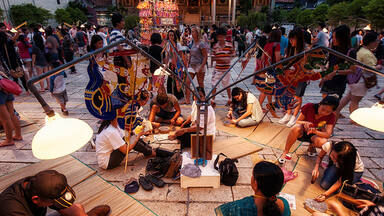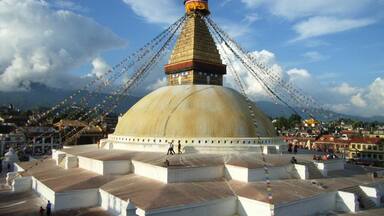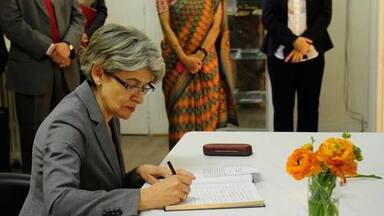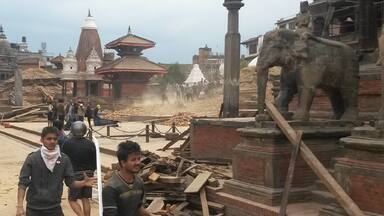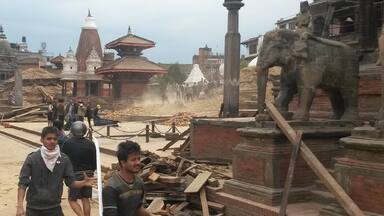Nepal’s museums re-opening post-earthquake

Just over one year ago, on 25 April 2015, Nepal was devastated by an earthquake and its subsequent aftershocks. This natural disaster heavily damaged Nepal’s cultural and natural heritage, including 691 historic buildings in 16 districts, of which 131 fully collapsed. Rapid visual assessment showed that the monuments, institutions and sites within the World Heritage site of Kathmandu Valley were heavily affected.
Today, progress from ongoing partnership and hard work can be celebrated.
In the months following the disaster, UNESCO and Nepal’s Department of Archaeology (DoA) joined together in salvaging, inventorying and ensuring the safe-storage of artefacts and other architectural features in several impacted sites and museums including Hanumandhoka, Swayambhu and the National Museum in Chhauni. It has been especially important to train local museum staff in earthquake recovery, safe storage and access of museum collections.
For example in February 2016, workshops organized by UNESCO, the DoA, ICCROM, the Institute for Disaster Mitigation of Urban Cultural Heritage at Ritsumeikan University, and ICOMOS Nepal, with the generous support of the Norwegian Ministry of Climate and Environment, trained 30 staff from museums in Kathmandu and other museums such as Pokhara, Kapilvastu, Nuwakot and Dhangadi. Focusing on sustainable collection and storage, surface cleaning, stabilization, labelling and packing of museum objects, participants gained technical, scientific and practical skills to save museum collections.
A storage facility funded by UNESCO was also set-up as part of the workshops, protecting some 300 displaced objects. A further 2,955 objects are in the process of being assessed, packed and labelled for safe storing.
In July 2016, UNESCO joined hands with the Nepal’s National Museum and the DoA to start working on digitalization of the Museum’s collection for a systematic inventory. UNESCO’s multidisciplinary team including art historians, archaeologists, and database experts is working closely with the museum staff and technicians to assess conditions, identify software needs and implement training.
Today, the National Museum, the Patan Museum, the Panauti Museum and the National Art Gallery are once again open and visitors are coming back to enjoy their rich collections. However, much still remains to be done and other museums have yet to open their doors. The importance of local communities and volunteers in this work cannot be underestimated. For example, local volunteers have been guarding sites to prevent the looting of objects.
Cultural heritage constitutes a source of identity and pride, and its protection is essential for sustainable development and especially for the tourism economy in Nepal. The future rebuilding program is in great need of support, and UNESCO aims to incorporate means for visitors to see, understand and contribute to the restoration process. Furthermore, rebuilding and conservation work needs to be part of a wider sustainable development strategy.
According to Christian Manhart, Director of UNESCO’s Kathmandu Office, “The rehabilitation of Nepal’s museums and historical buildings following the 2015 earthquake has a deep, positive impact on the economic and social development of the country. There is a tremendous sense of identity, determination and hope that comes with the reopening of museums and the restoration of temples.”
The Post Disaster Needs Assessment for Nepal outlines short-term recovery and repair needs as well as long-term restoration and rebuilding plans. It proposes the total restoration of the damaged heritage sites within six years, as outlined in the Post Disaster Restoration Framework.
With so much important work still ahead, UNESCO continues to seek support to carry forward initiatives that will ensure Nepal’s museums and monuments return to their pre-earthquake splendour, for all to enjoy.
Useful links:
- Kathmandu Valley World Heritage site
- Post Disaster Need Assessment (PDNA)
- Post Disaster Recovery Framework
- UNESCO raises safety concerns on the reopening of Kathmandu Valley World Heritage Site
- UNESCO to assess the impact on Nepal’s cultural heritage of the devastating earthquake
- Overview Report of the Nepal Cultural Emergency Crowdmap Initiative
- Workshops boost post-quake recovery of cultural heritage in Nepal
